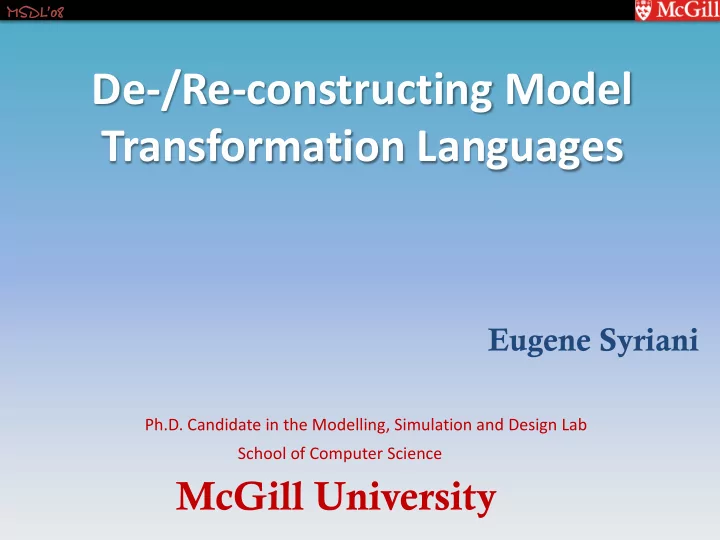

MSDL’08 De-/Re-constructing Model Transformation Languages Eugene Syriani Ph.D. Candidate in the Modelling, Simulation and Design Lab School of Computer Science McGill University
MSDL’08 OVERVIEW Context De-Constructing Transformation Languages — Collection of MT primitives Re-Constructing Transformation Languages — FUJABA — More esoteric features MoTif-Core: a re-construction example — MoTif — GReAT Conclusion 2
MSDL’08 THE BIG PICTURE
MSDL’08 IN THE CONTEXT • Many different model transfromation languages (MTLs) – Features [1]: atomicity, sequencing, branching, looping, non-determinism, recursion, parallelism, back-tracking, hierarchy, time – Transformation rule: matching + rewriting + validation • Hard to – Compare expressiveness – Provide framework for interoperability • Express MTLs in terms of primitive building blocks – De-Construction: small set of most primitive constructs – Re-Construction: discover new MTLs + interoperation + optimization [1] Syriani, E. and Vangheluwe, H. (2009) Matters of model transformation. Technical Report SOCS-TR-2009.2. McGill University, School of Computer Science. 4
MSDL’08 DE-CONSTRUCTING TRANSFORMATION LANGUAGES T-Core Module • 8 primitives • Composition operator • 3 types of messages • Exchange of messages through methods • 3 output states: – Success – Fail – Exception 5
MSDL’08 DE-CONSTRUCTING TRANSFORMATION LANGUAGES Matcher 1. Find all matches (parameter) 2. Store result in packet 6
MSDL’08 DE-CONSTRUCTING TRANSFORMATION LANGUAGES Rewriter 1. Check validity of packet 2. Apply transformation 3. Propgate changes in all match sets 4. Consume match Exception possible! 7
MSDL’08 DE-CONSTRUCTING TRANSFORMATION LANGUAGES Iterator 1. Check if match set is not empty 2. Randomly choose a match 8
MSDL’08 DE-CONSTRUCTING TRANSFORMATION LANGUAGES Rollbacker 1. Push packet onto stack 1. Match set not empty: there are matches left (pass on) 2. No match set: back-track to previous state 9
MSDL’08 DE-CONSTRUCTING TRANSFORMATION LANGUAGES Resolver 1. Conservative check for potential conflict between different matches in match sets (parameter) 2. Customizable resolution function Exception possible! 10
MSDL’08 DE-CONSTRUCTING TRANSFORMATION LANGUAGES Selector 1. successIn : add to success set 2. failIn : add to fail set 3. Choose randomly first from success then from fail Exception possible! 11
MSDL’08 DE-CONSTRUCTING TRANSFORMATION LANGUAGES Synchronizer 1. successIn : add to success set 2. failIn : add to fail set 3. Merge only if all threads succeeded 4. Customizable merge function Exception possible! 12
MSDL’08 DE-CONSTRUCTING TRANSFORMATION LANGUAGES Composer 1. Meaningfully composes its sub-primitives 2. User-defined composition 13
MSDL’08 DE-CONSTRUCTING TRANSFORMATION LANGUAGES Motivating T-Core • De-construct up to what level? • What to include, what to exclude? – Pre/PostConditionPattern: rules, bi-directional, functions – Separation match/rewrite: queries, nested transformaitons – Packet: sufficient info to be processed by each primitive, designed for concurrent transformations – Composition: scaling for large model transformations – T-Core module: open for more building blocks, extendable 14
MSDL’08 RE-CONSTRUCTING TRANSFORMATION LANGUAGES 15
MSDL’08 RE-CONSTRUCTING TRANSFORMATION LANGUAGES FUJABA for-all Pattern [2] [2] Fischer, T., et. al., (2000) Story diagrams: A new graph rewrite language based on the UML and Java. In Ehrig, H., et al., (eds.), Theory and Application of Graph Transformations, LNCS, 1764, pp. 296 – 309. Springer-Verlag. 16
MSDL’08 RE-CONSTRUCTING TRANSFORMATION LANGUAGES FUJABA for-all Pattern 17
MSDL’08 RE-CONSTRUCTING TRANSFORMATION LANGUAGES FUJABA for-all Pattern 18
MSDL’08 RE-CONSTRUCTING TRANSFORMATION LANGUAGES Amalgamation rules: Repotting the geraniums [3] “ Repot all flowering geraniums whose pots have cracked” [3] Rensink, A. and Kuperus, J.-H. (2009) Repotting the geraniums: On nested graph transformation rules. In Margaria, T., Padberg, J., and Taentzer, G. (eds.), GT- VMT’09, EASST. 19
MSDL’08 MOTIF-CORE = DEVS + T-CORE [4] [4] Zeigler, B. P. (1984) Multifacetted Modelling and Discrete Event Simulation. Academic Press. 20
MSDL’08 MOTIF-CORE: TIMED MTLS MoTif AtomicRule [5] • Time • Exceptions [5] Syriani, E. and Vangheluwe, H. (2009) Discrete-Event Modeling and Simulation: Theory and Applications. CRC Press, Boca Raton (USA). 21
MSDL’08 MOTIF-CORE: TIMED MTLS GReAT Test/Case block [6] • Asynchrony • Parallelism [6] Agrawal, A., Karsai, G., Kalmar, Z., Neema, S., Shi, F., and Vizhanyo, A. (2006) The design of a language for model transformations. SoSym, 5, 261 – 288. 22
MSDL’08 MOTIF-CORE: TIMED MTLS More Readable: Repotting the geraniums 23
MSDL’08 CONCLUSION • Collection of MT primtives: T-Core • Re-construction of existing MTLs (comparable) • New -Construction of novel MTLs: MoTif-Core • Future Work – Efficiently implement these primitives – Compare MoTif-Core with QVT-Core 24
MSDL’08 Let’s discuss 25
Recommend
More recommend